Table of Content
Data in the right hands can be immensely powerful and critical to any decision making. For example, data can prove very useful when discovering the reasons, causes, or the impact of changing conditions or behaviours in specific scenarios. That being said, when analysing substantial amounts of data, simple statistics can divulge a great deal of information.
However, it is usually more imperative to critically examine relationships within the data as sometimes data can be grossly misunderstood. This is especially seen in instances related to correlation and causation, where understanding their respective differences is vital to effective marketing, as confusing these concepts can lead to costly mistakes.
Throughout today’s article, we will labour to unpack the distinctions between causation and correlation in relation to mobile marketing, as well as the nuances that characterise both. So, without further ado, let’s dive in!
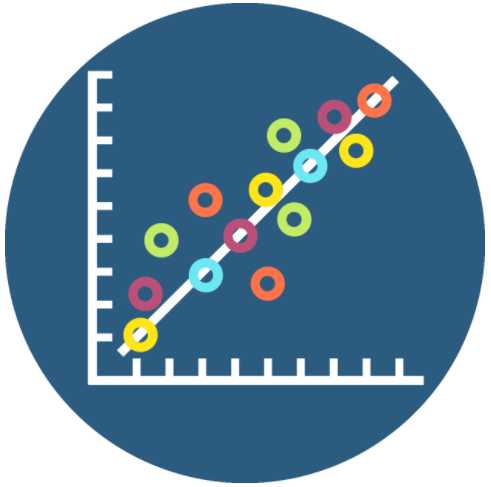 Image credit: learningspaces.dundee.ac.uk
Image credit: learningspaces.dundee.ac.uk
What Is Correlation?
Generally speaking, correlation is a statistical measure leveraged to demonstrate the linear relationship between two continuous variables, for instance, height and weight. Typically, correlation is utilised to estimate the strength or direction between two or more variables that maintain a linear relationship.
Overall, correlation constitutes statistical relationships that involve dependence. For example, the correlation between the physical height of parents and their children or the correlation between the demand for an item and its price. In principle, these two events relate to each other. However, if one event does not occur, the other will still happen somehow.
This phenomenon is easily exemplified by the Pearson correlation, which measures the linear relationship between two variables.
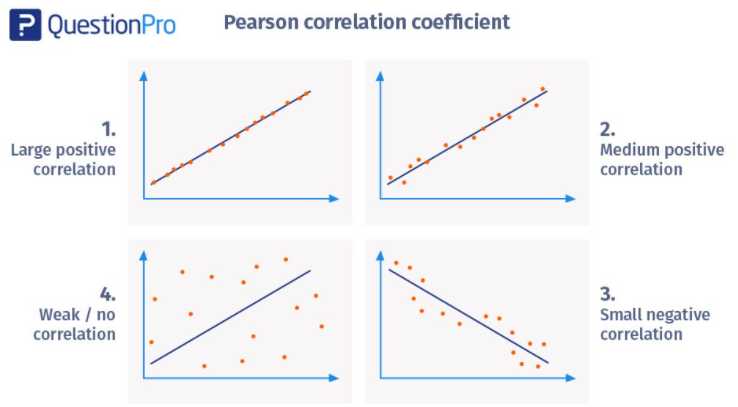 A demonstration of the Pearson coefficient. Image Credit: questionpro.com
A demonstration of the Pearson coefficient. Image Credit: questionpro.com
The Different Types of Correlation
- Positive Correlation
In practice, a positive correlation essentially demonstrates the relationship between two variables where the value of two variables increases or decreases concurrently. For instance, time spent studying and score averages, education and income levels, or poverty and crime levels.
- Negative Correlation
Generally speaking, a negative correlation depicts a relationship between two variables where the value of one variable increases while the other decreases—for instance, green cars and accident rates, or product supply and demand.
- No Correlation
In no correlation, two variables are completely unrelated. For instance, change in B creates no changes in D, or the other way around.
What Exactly Is Causation?
Causation, also known as causality, is essentially a form of correlation where a change in one variable will effect a change in the other variable. In practice, two variables will be related, and one can infer what will happen to one variable, when the other one is changed.
In practice, causation depicts the physical relationship between a cause and its effect. As such, it assumes the capacity of one variable will impact the other, where the first variable brings the second one into existence. However, the second variable can fluctuate because of the first variable. For the most part, causation works on the premise that events happen in predictable ways.
Generally, causation is a sophisticated concept. For example, C might affect D; however, multiple things may affect D that might not affect C. Thus, events have many causes. Nonetheless, the central theme of ‘cause’ means D always happens if C occurs, and D never occurs if C does not happen.
As an example, a car accident can be caused by defective brakes, driver incompetence, poor road design, ice, or the evolution of humans—all at the same time. However, if one eliminates the things they cannot change as irrelevant and the things that are so complex that changing them is not an efficient way to cause predictable changes in D, in that case, they can arrive at a useful definition of “cause.”
Overall, in our daily lives, causation is transitive. This means that if A causes B and this B also causes C, then we typically accept that A causes C. This concept is often called indirect causation.
While this might be a bit confusing, hang in there. We are going to elaborate more as we proceed.
Differences Between Causation vs Correlation
Typically, many people understandably confuse correlation with causation by typically interpreting non–zero correlation as an implied causal relationship. However, one thing is important to keep in mind: correlation does not mean causality.
To demonstrate the distinction between correlation and causation, let us use an example of ice cream and car thefts. When the sales of ice cream rise, then the number of cars stolen can also rise. However, it is not valid to say that ice cream consumption is the reason behind the stolen cars. As such, there is no causal relationship between stolen vehicles and ice cream.
Consequently, this means a third reason could explain the correlation between sales of ice cream and car thefts, which could be the weather. Though in the summer, both ice cream sales and car thefts could both increase, which means that while they do not have a causal relationship, they are still correlated. Put simply, correlation does not imply causation.
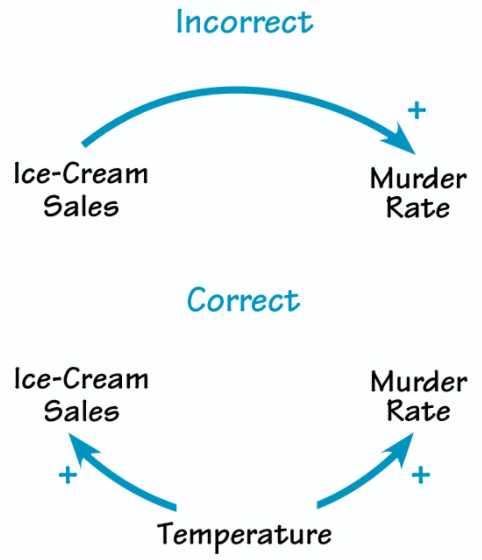 Image Credit: towardsdatascience.com
Image Credit: towardsdatascience.com
Proving Correlation Is Simpler Than Proving Causation
Correlation demonstrates that a mathematical relationship always exists. For example:
(1) changing A causes B to change
(2) changing B causes A to change
(3) changing Z (another variable) causes A and B to change
(4) a common co-occurrence is when you take two phenomena that change over time and are linear with respect to time, they will typically correlate with each other
On the other hand, causation is exemplified by occurrences 1 or 2 and tends to be more specific (as it has a direction where either A causes B or B causes A. However, proving causation is much more challenging as one cannot magically change the size of children’s feet to see if their intelligence changes, as an example.
As we already established, there is a considerable correlation between things with a causal relationship, and things that are closely correlated. This is primarily because causation requires correlation. However, the inverse, however, is not valid. Things that are closely correlated do not necessarily have a strong causal relationship. In a sense, causal relationships are a subset of closely correlated things because correlation does not imply causation.
Another example of causation is if Facebook wants to know whether putting ads on news feed rather than on the side will cause people to click more often, it can run an experiment. In such an experiment, they can randomly select 500 million users to display ads on a news feed, another 500 million to display ads on the side. So, if one ratio is higher than the other substantially, Facebook can conclude a causation effect of ad location on click rate because by randomisation, thus “confounding factors” cancel out. As a result, correlation doesn’t imply causation because of “confounding factors”, which are hidden factors that can affect the variables being considered.
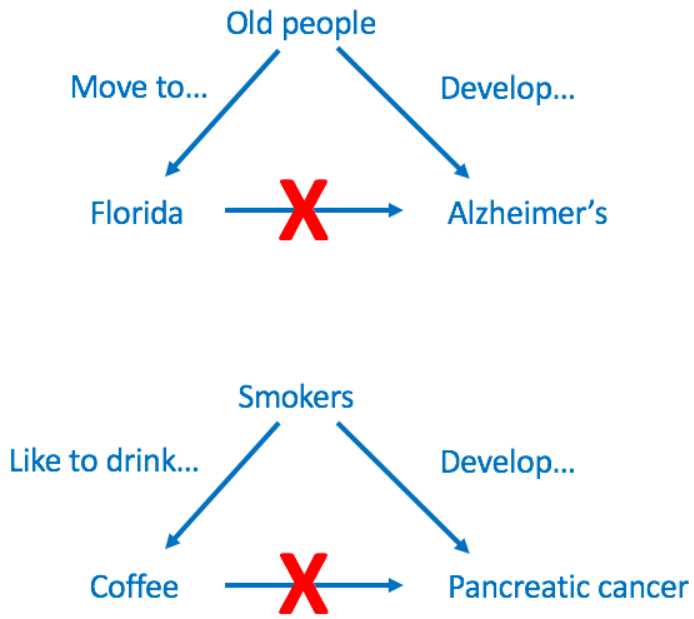 How confounding factors show that correlation does not mean causation. Image Credit: www.acsh.org
How confounding factors show that correlation does not mean causation. Image Credit: www.acsh.org
How to Employ Causation and Correlation in Mobile Marketing
Ascertaining causation enables developers and marketers to understand the levers at their disposal to impact customer behaviours. With this knowledge, they can better plan, develop, target, and implement their mobile advertising budgets.
That being said, while correlation on its own provides actionable clues, marketers shouldn’t base their plans on correlation alone. Rather, they should be based on experiments designed to establish causation. Other ways marketers can use these concepts are:
To replicate events in order to verify results
Many intelligent companies essentially run controlled experiments to isolate causal relationships by shutting down marketing channels one by one. For instance, if a company runs a mobile ad and sees an increase in traffic, they will want to confirm whether it’s not due to another channel like a paid search campaign.
So, when applied well, causation and correlation can help one to confirm the origins of a traffic boost on a particular channel by conducting tests to ensure it’s not a fluke via a control group or tracking ad-driven traffic versus other sources. The overall idea is to determine the incremental value of an ad and whether it is substantially higher than regular traffic by isolating and testing the different channels.
To analyse the impact of correlation versus causation across different channels
When it comes to attribution, marketers often confuse causation and correlation as different channels influence outcomes disparately.
Marketers should always be aware of the fact that they can be wrong about both the correlation and the causation in the data. So, before jumping to random conclusions about either data, it’s important to review performance on all channels and account for any new marketing initiatives.
To avoid confirmation bias
Correlation can help you confirm if a specific channel is less effective than others, as you’re more likely to see causation that isn’t really there.
For example, if you want to market a new deodorant to women aged 20 to 40, then invite women who have already tried the product to answer a survey. Since you expect positive responses, chances are that you’ll interpret the results as favourable to the product. However, someone else might read the survey results and conclude that most women actually disliked the deodorant.
In such instances, it is important to exploit quantitative data to confirm your hunches and design campaigns around factual information. You can dissect collected data and interpret the numbers to identify relationships within them, with a clear understanding of causation and correlation to curate an effective campaign.
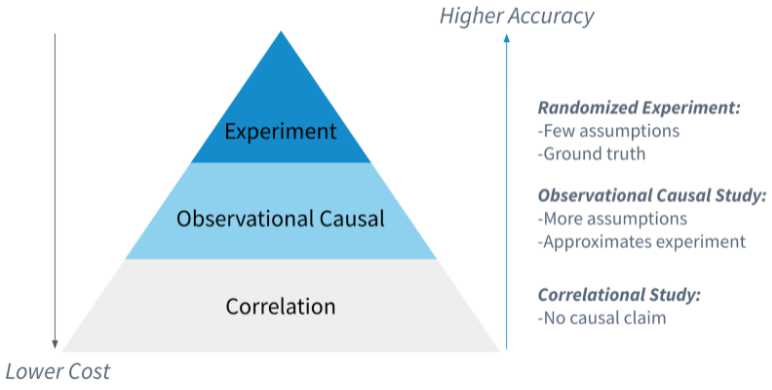 Image Credit: mitpress.mit.edu
Image Credit: mitpress.mit.edu
Bottom Line
In conclusion, causation typically implies correlation, however, the converse is not always true. There are too many correlations in the world, for example, there are hundreds of correlations between basketball statistics and stock prices, yet none of them may be causally related. Similarly, thousands of correlations are identified between parts of human DNA and several diseases, yet few of them may be causally related.
As statistics multiply, the potential number of correlations grows exponentially, but the number of causal relationships grows much slower. So, overall, there is zero correlation between correlation and causation. Ultimately, correlation is a good starting point for discovering causation in mobile marketing.
Looking for a top-notch Mobile App Developer Malaysia? Your search ends here! Contact us now to bring your app idea to life with expert developers.

